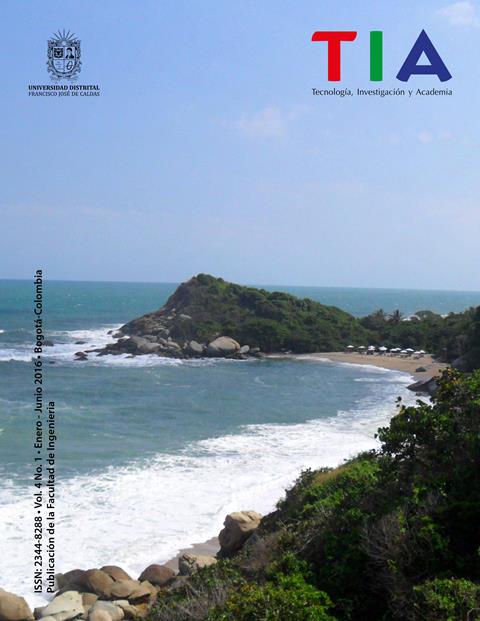Publicado:
2016-04-11Número:
Vol. 4 Núm. 1 (2016): enero-junioSección:
InvestigaciónRevisión del contexto operacional del software de monitoreo y control en tierra de un nanosatélite
Palabras clave:
Nanosatélite, Estación Terrena, Software, Monitoreo y control (es).Descargas
Resumen (es)
El software de monitoreo y control en tierra es el sistema que permite controlar el funcionamiento del payload de un satélite de tipo académico. Debido a los requerimientos específicos de cada misión y su funcionalidad, este software debe ser desarrollado a la medida. En este documento se presenta una descripción general de las características que definen el funcionamiento de un sistema nanosatelital, de manera que permitan estructurar el contexto operacional del software de monitoreo y control en tierra como etapa inicial de su proceso de desarrollo.
Referencias
DePasquale, D.; Bradford, J. (2013). Nano/Microsatellite Market Assessment. SpaceWorks Enterprises, Inc. (SEI).
Puig-Suari, J.; Turner, C.; Ahlgren, W. (2001). Development of the standard CubeSat deployer and a CubeSat class PicoSatellite. Aerospace Conference, 2001, IEEE Proceedings, 1: 347-353.
Triana, J. S.; Bautista, S.; Díaz, F. A. (2015). Identification of design considerations for small satellite remote sensing systems in low earth orbit. Journal of Aerospace Technology and Management JATM, 7(1): 121-134.
Lu, W.; Tan, Y.-P. (2003). Color filter array demosaicking: New method and performance measures. Image Processing, IEEE Transactions on, 12(10), 1194-1210.
Woellert, K.; Ehrenfreund, P.; Ricco, A. J.; Hertzfeld, H. (2011). CubeSats: Cost-effective science and technology platforms for emerging and developing nations. Advances in Space Research, 47(4), 663-684.
Ippolito Jr., L. J. (2008). Satellite Communications Systems Engineering: Atmospheric Effects, Satellite Link Design and System Performance. New York: John Wiley & Sons.
Addaim, A.; Kherras, A.; Zantou, B. (2007). Design of store and forward data collection low-cost nanosatellite. Aerospace Conference, IEEE: 1-10.
Fortescue, P.; Swinerd, G.; Stark, J. (Eds.). (2011). Spacecraft Systems Engineering. 4th Ed. New York: John Wiley & Sons.
Schor, D.; Kinsner, W.; Thoren, A. (2009). Satellite ground station emulator: An architecture and implementation proposal. Electrical and Computer Engineering, CCECE ’09, IEEE: 868-873.
Ubbels, W. J. et al. (2005). Delfi-C3: A student nanosatellite as a test-bed for thin film solar cells and wireless onboard communication. Recent Advances in Space Technologies, RAST. Proceedings of 2nd International Conference, IEEE: 167-172.
Simms, L. M. et al. (2011). Optical payload for the STARE mission. Society of Photo-Optical Instrumentation Engineers (SPIE) 8044.
Montenbruck, O.; Gill, E. (2012). Satellite Orbits: Models, Methods and Applications. Berlin: Springer Science & Business Media.
Cristea, O.; Dolea, P.; Dascăl, P. V. (2009). S-band ground station prototype for low-earth orbit nanosatellite missions. Telecomunicaţii, LII(1): 64-71.
Jussila, J. (2013). S-Band Transmitter for Aalto-1 Nanosatellite (Master’s thesis). Helsinki: School of Electrical Engineering, Aalto University.
Fischer, M.; Scholtz, A. L. (2010). Design of a multi-mission satellite ground station for education and research. Advances in Satellite and Space Communications (SPACOMM), Second International Conference, IEEE: 58-63.
Aslan, A. R. et al. (2013). Development of a LEO communication CubeSat. Recent Advances in Space Technologies (RAST), 6th International Conference, IEEE: 637-641.
Kasser, J. E. (1995). Amateur radio: Past, present and future. IEE, 41(1): 120-127.
Alminde, L.; Bisgaard, M.; Vinther, D.; Viscor, T.; Ostergaard, K. (2002). Robustness of Radio Link between AAU-CubeSat and Ground Station. Aalborg (Denmark): Department of Control Engineering, Aalborg University.
Nonsoque, C. A.; Molano, J. D; Espíndola, J. E. (2012). Montaje e implementación de una estación terrena satelital para el seguimiento de satélites de órbita baja. Panamá: 10th LACCEI Latin American and Caribbean Conference.
Ichikawa, D. (2006). CubeSat-to-Ground Communication and Mobile Modular Ground-Station Development. Honolulu: Department of Electrical Engineering, University of Hawaii at Manoa.
Damerow, H.; Schwarz, J. (2003). Satellite data reception system at multimissin ground station. Acta Astronautica, 52(9): 753-756.
Kristensen, J., Winther, B. (2009). Mission Control Center (Doctoral dissertation). Kongens Lyngby (Denmark): Danmarks Tekniske Universitet, DTU.
Gilmore, J. S.; Wolhuter, R. (2009). Predicting low earth orbit satellite communications quality and visibility over time. Southern Africa Telecommunication Networks and Applications Conference (SATNAC).
Kim, K.; Bang, H.; Chae, J.-S.; Park, H.-Y.; Lee, S.-H. (2011). Ground station design for ST- SAT-3. International Journal of Aeronautical and Space Sciences, 12(3), 283-287.
Vangli, H. (2010). Construction of a Remotely Operated Satellite Ground Station for Low Earth Orbit Communication (Master’s thesis). Oslo: Department of Physics, University of Oslo.
Cutler, J. W.; Kitts, C. A. (1999). Mercury: A satellite ground station control system. Aerospace Conference, IEEE, 2: 51-58.
Lu, W.; Tan, Y.-P. (2003). Color filter array demosaicking: New method and performance measures. Image Processing, IEEE, 12(10): 1194-1210.
Ingle, V.; Proakis, J. (2011). Digital Signal Processing Using MATLAB. Boston: Cengage Learning.
Hermansen, B. S. (2006). A Satellite Mission Control System (Doctoral dissertation). Kongens Lyngby (Denmark): Danmarks Tekniske Universitet, DTU.
Du, Y. (2005). A Satellite Ground Station (Informatics and Mathematical Modelling thesis). Kongens Lyngby (Denmark): Danmarks Tekniske Universitet, DTU.
Choi, J. H. (2013). Ground Segment Software Design and Development for Nanosatellite Space Missions (Doctoral dissertation). Toronto: University of Toronto.
Cómo citar
APA
ACM
ACS
ABNT
Chicago
Harvard
IEEE
MLA
Turabian
Vancouver
Descargar cita
Visitas
Descargas
Licencia
Reconocimiento – NoComercial – CompartirIgual (by-nc-sa): No se permite el uso comercial de la obra original, las obras derivadas deben circular con las mismas condiciones de esta licencia realizando la correcta atribución al autor.
Esta obra está bajo una licencia de Creative Commons Reconocimiento-NoComercial-CompartirIgual 4.0 Internacional




